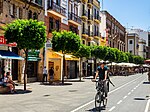Treasure of El Carambolo

The Treasure of El Carambolo (Spanish: Tesoro del Carambolo) was found in El Carambolo hill in the municipality of Camas (Province of Seville, Andalusia, Spain), 3 kilometers west of Seville, on 30 September 1958. The discovery of the treasure hoard spurred interest in the Tartessos culture, which prospered from the 9th to the 6th centuries BCE, but recent scholars have debated whether the treasure was a product of local culture or of the Phoenicians. The treasure was found by Spanish construction workers during renovations being made at a pigeon shooting society.After years of displaying a replica while the original treasure was locked in a safe, the Archeological Museum of Seville has put the original artifacts on permanent display since January 2012. A replica is on display in the National Archaeological Museum in Madrid.
Excerpt from the Wikipedia article Treasure of El Carambolo (License: CC BY-SA 3.0, Authors, Images).Treasure of El Carambolo
Camino de Guía,
Geographical coordinates (GPS) Address Nearby Places Show on map
Geographical coordinates (GPS)
| Latitude | Longitude |
|---|---|
| N 37.392936111111 ° | E -6.0371166666667 ° |
Address
El Carambolo
Camino de Guía
41900
Andalusia, Spain
Open on Google Maps









